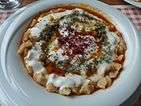Manti (food)
| |||
| Alternative names | Mantu | ||
|---|---|---|---|
| Type | Dumpling | ||
| Created by | Disputed | ||
| Main ingredients | Spiced meat (lamb or ground beef) | ||
| Ingredients generally used | Yogurt, garlic | ||
Manti (Uyghur: مانتا , manta, monta, Kazakh: мәнті, mänti, مأنتى, Turkish: mantı, Uzbek: manti, monti, Armenian: մանթի, Tatar: манты; indicates either singular or plural) or mantu (Kyrgyz: мантуу or манты; Pashto, Persian, Arabic: منتو) are dumplings popular in most Turkic cuisines, as well as in the South Caucasian, Central Asian, Afghanistan Chinese Islamic.[1] Nowadays, manti are also consumed throughout Russia and other post-Soviet countries, where the dish spread from the Central Asian republics.[2] The dumplings typically consist of a spiced meat mixture, usually lamb or ground beef in a dough wrapper, and either boiled or steamed. Size and shape vary significantly depending on the geographical location.[1] Manti resemble the Chinese jiaozi, Korean mandu, Mongolian buuz, and the Tibetan momo, and the dish's name is cognate with the Korean mandu, Chinese mantou, and Japanese manjū, although the Chinese and Japanese counterparts refer to different dishes.[1][3][4]
History

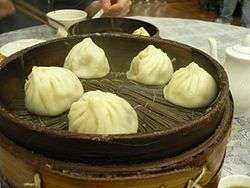
The origin is somewhat uncertain.[2][5][6] While the Chinese word "mantou" has been suggested as the origin for the word "manti", this word had several different spellings in Chinese in the past indicating that the Chinese attempted to adapt a foreign word to their writing system.[1] Originally, mantou was meat filled. Mantou still retains its old meaning as stuffed bun in Wu Chinese as moedeu. But in Mandarin and many other varieties of Chinese, mantou refers to steamed bun, while baozi resembles the ancient mantou stuffed with meat.[6][7][8][9] The most widely held theory of its origins is that migrating Turkic-speaking people brought the mantu dough with them to Anatolia, where it evolved into the Turkish manti. Some variations may be traced back to the Uyghur people of northwest China. When the Tatars settled into the Kayseri region of modern day Turkey, the area became known for it manti.[10] The dish may have originated in the territories of Mongol Empire.[11][12] While the etymological link between man tou and mantı is debated, there is agreement that the recipe was carried across Central Asia along the Silk Road to Anatolia by Turkic and Mongol peoples.[13][14] One of the earliest mentions of a dumpling similar to Turkish manti is written in the 1330 treatsie, Yinshan Zhengyao by Hu Sihui, the imperial doctor in service of the Yuan Dynasty Emperor, Buyantu Khan.[15]
According to Holly Chase, "Turkic and Mongol horsemen on the move are supposed to have carried frozen or dried manti, which could be quickly boiled over a camp-fire".[16] According to an Armenian researcher, manti first reached Cilician Armenia as a result of the cultural interaction between Armenians and Mongols during their alliance in the 13th century.[17] Migrating Turkic-speaking peoples brought the mantu dough with them to Anatolia, where it evolved into the Turkish mantı. When the Tatars settled into the Kayseri region of modern-day Turkey, the area became known for its manti.[18] Korean mandu is also said to have arrived in Korea through the Mongols in the 14th century.[19] However, some researchers do not discount the possibility that manti may have originated in the Middle East and spread eastward to China and Korea through the Silk Road.[14]:290
The earliest written Ottoman mantı recipe appears in a 15th-century cookbook written by Muhammed bin Mahmud Shirvani. The version in Shirvani's book is a steamed dumpling with a minced lamb and chickpeas filling spiced with cinnamon and flavored with vinegar. The dish was garnished with sumac and like most contemporary mantı variations, it was served with a garlic-yoghurt sauce.[20]
Many early Turkish cookbooks do not mention a dish called mantı. The first printed recipe book, Melceüt`t Tabâhhin, was published in 1844. It includes a recipe for a dish called tatar boreği, which is similar to mantı but is not served with garlic yoghurt sauce. The first English language Ottoman cookbook and a third cookbook printed in 1880 includes this same recipe. Another 1880 cookbook does have a recipe for mantı, but instead of a dumpling, it is a dish composed of layered dough served with mincemeat and garlic yogurt. This book also includes a recipe of piruhi—a cheese filled version of the tatar boreği recipe.[20]
In Central Asian cuisines
Manti in Central Asian cuisines are usually larger in size. They are steamed in a multi-level metal steamer called mantovarka, mantyshnitsa (Russian terms for manti cooker), manti-kazan or manti-kaskan (manti pot). It consists of layered pots with holes, that are placed over a boiling stock and water.
In Kazakh cuisine, the manti filling is normally ground lamb (sometimes beef or horse meat), spiced with black pepper, sometimes with the addition of chopped pumpkin or squash. This is considered to be a traditional Uyghur recipe. Manti are served topped with butter, sour cream or an onion sauce or garlic sauce. When sold as street food in Kazakhstan, manti are typically presented sprinkled with hot red pepper powder.
In Uzbek, Tajik and Kyrgyz cuisines, manti are usually made of one (or a combination) of the following ingredients: lamb, beef, cabbage, potato or pumpkin, with fat often added to meat manti. Steaming, frying and boiling are all common. Manti are usually topped with butter and served with sour cream, tomato sauce or fresh onion rings (sprinkled with vinegar and black pepper). A sauce made by mixing vinegar and chilli powder is also common. In Uzbekistan, manti are also called kaskoni.[21]
The same style of cooking manti is traditional for Tatar, Bashkir and other cuisines of the Turkic peoples living in the vast area from Idel-Ural to the Far East. It is nowadays widespread throughout Russia and other post-Soviet countries.
- Mantovarka
.jpg) Uzbek manti
Uzbek manti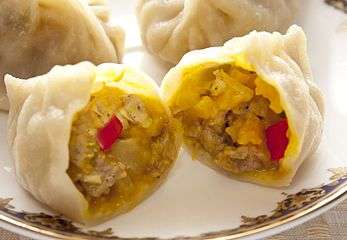 Manti filled with pumpkin
Manti filled with pumpkin
In Afghan cuisine
In Afghan cuisine, the mantu are filled with beef or lamb mixed with minced onions and spices, steamed and then topped with a very typical sauce (seer mosst, lit. ‘garlic yoghurt’) of yoghurt, dried or fresh mint, lemon juice and minced or pressed garlic. The mantu are also typically topped with a very small amount of tomato-based sauce which can include split peas, red kidney beans and/or some sautéed ground meat. The amount of yoghurt sauce is typically much greater than the tomato sauce; the tomato sauce is meant to be dotted on top - not covering the dish.[22] Chutney, a spicy green or red pepper condiment sauce, may be sprinkled on top. Many Afghans also like to serve mantu with a carrot qorma or stew, instead of a tomato-based sauce.[22]
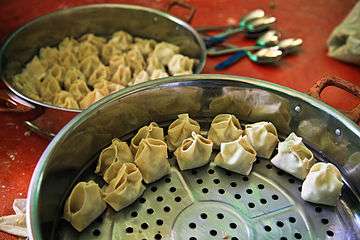 Afghan manti in a steamer before cooking
Afghan manti in a steamer before cooking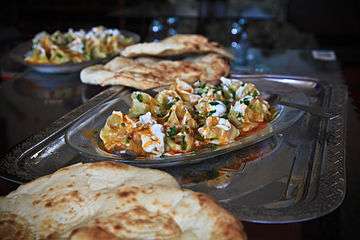 Afghan dish of mantu
Afghan dish of mantu
In Armenian, Turkish and South Caucasian cuisines
In contrast to the Central Asian varieties, manti in Anatolia and Transcaucasia are usually boiled or baked rather than steamed and tend to be small in size. A mid-15th-century Ottoman recipe has survived, with the manti filled with pounded lamb and crushed chickpeas, steamed, and served topped with yoghurt mixed with crushed garlic and sprinkled with sumac.[23] In modern Turkish cuisine, manti are typically served topped with yoghurt and garlic, and spiced with red pepper powder and melted butter, and topped with ground sumac and/or dried mint by the consumer.
Similarly, the Armenian manti, also sometimes referred to as monta, are usually served with yoghurt (matzoon) or sour cream (ttvaser) and garlic, accompanied by clear soup (mantapour). Manti are more common among western (Cilician) Armenians, while among eastern Armenians, Georgians and Azerbaijanis, similar dumplings called khinkali are more prevalent.
Although there are many different variations of manti in terms of shape and way of serving, the most praised type of Turkish manti is known as Kayseri mantisi, originally from Kayseri, an Anatolian city. Kayseri mantisi is tiny and served with yoghurt, melted butter (flavored with Aleppo pepper) and seasoning including dry mint and Aleppo pepper flakes.[24] It can also be served with the water or chicken broth it was boiled in, and often in Kayseri it is consumed as a soup prior to the main dish. In Kayseri, when a couple is engaged to be married, the mother of the groom visits the bride's house and during this visit the bride should prepare manti for her prospective mother-in-law. The smaller the manti dumplings are, the more skillful the bride is considered to be in the kitchen. Traditionally the dumplings prepared for the prospective mother-in law are supposed to be so small that 40 of them can be fit into one spoon. Manti may be made from shredded meat of quail, chicken or goose in some regions of Turkey, while boş mantı (‘empty dumpling’) lack filling entirely.
Tatar boreği is similar to mantı. In North Cyprus is traditionally served with grated halloumi cheese and mint.[25]
Similarly small dumplings are also found in other Turkic cuisines but they are not considered to be a type of manti. Examples are dushbara in Azerbaijani cuisine and chuchvara in Uzbek cuisine.
 Baked Armenian manti
Baked Armenian manti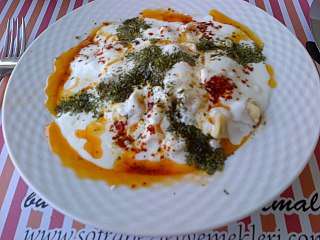 Turkish mantı with melted butter, garlic-yogurt sauce and Aleppo pepper
Turkish mantı with melted butter, garlic-yogurt sauce and Aleppo pepper
In Bosnian cuisine
In Bosnian cuisine, the name klepe is used. These are made of minced meat with onions. It is served in a sauce consisting of yogurt and garlic. There is also a separate dish called mantije, which is made of the same ingredients, but the pastry balls are put together with no free space in between and baked. After the baking yogurt is poured on top. This second type is considered to be a pita or börek rather than manti, and is primarily made in the region of Sandžak.
See also
- Manjū, a Japanese confection which also originated from Chinese mantou
References
- 1 2 3 4 Davidson 2014, p. 493.
- 1 2 More Than Just Another Dumpling, The School of Russian and Asian Studies, retrieved 25 January 2014
- ↑ Hudgins 1997, pp. 142, 154.
- ↑ Gordon 2009, p. 13.
- ↑ http://www.hurriyetdailynews.com/turkish-manti-chinese-mantou.aspx?pageID=238&nID=40392&NewsCatID=473
- 1 2 James A. Millward (15 March 2013). The Silk Road: A Very Short Introduction. Oxford University Press. pp. 62–. ISBN 978-0-19-979079-1.
- ↑ Andrew Coe (16 July 2009). Chop Suey: A Cultural History of Chinese Food in the United States. Oxford University Press. pp. 89–. ISBN 978-0-19-975851-7.
- ↑ PPC. Prospect Books. 1983. p. 30.
- ↑ http://www.fuchsiadunlop.com/dumpling-heaven-in-adelaide/ Archived 2016-05-31 at the Wayback Machine.
- ↑ Basan, Ghillie (1997). Classic Turkish Cookery. I.B.Tauris. ISBN 978-1-86064-011-7.
- ↑ http://www.hurriyetdailynews.com/turkish-manti-chinese-mantou.aspx?pageID=238&nID=40392&NewsCatID=473
- ↑ https://vimeo.com/105120171
- ↑ Fragner, Bert (2000). "From the Caucasus to the Roof of the World: a culinary adventure". In Sami Zubaida & Richard Tapper. A Taste of Thyme: Culinary Cultures of the Middle East (2nd ed.). London & New York: Tauris Parke Paperbacks. p. 60. ISBN 1-86064-603-4.
- 1 2 Anderson, E. N (2015). Food and Environment in Early and Medieval China. ISBN 978-0-8122-9009-7. Retrieved 2017-06-01.
- ↑ Husihui, Paul D. Buell, Eugene N. Anderson, tr., A Soup for the Qan: Chinese Dietary Medicine of the Mongol Era as Seen in Hu Szu-Hui's Yin-Shan Cheng-Yao: Introduction, Translation, Commentary and Chinese Text (London; New York: Kegan Paul International, 2000. ISBN 0710305834), p. 169.
- ↑ Chase, Holly (2000). "The Meyhane or McDonalds? Changes in eating habits and the evolution of fast food in Istanbul". In Sami Zubaida & Richard Tapper. A Taste of Thyme: Culinary Cultures of the Middle East (2nd ed.). London & New York: Tauris Parke Paperbacks. p. 81. ISBN 1-86064-603-4.
- ↑ Irina Petrosian, David Underwood, Armenian Food: Fact, Fiction & Folklore. Lulu.com, 2006. ISBN 1-4116-9865-7
- ↑ Basan, Ghillie (1997). Classic Turkish Cookery. I.B.Tauris. ISBN 978-1-86064-011-7.
- ↑ (in Korean) Mandu at Doosan Encyclopedia
- 1 2 McWilliams, Mark (2013-07-01). Wrapped & Stuffed Foods: Proceedings of the Oxford Symposium on Food and Cookery 2012. Oxford Symposium. ISBN 978-1-903018-99-6.
- ↑ Uzbekistan Country Study Guide Volume 1 Strategic Information and Developments. Int'l Business Publications. 2013. pp. 56–57. ISBN 1438775881.
- 1 2 Saberi, Helen (2000). "Pasta & Noodle Dishes". Afghan Food & Cookery: Noshe Djan. Hippocrene Books. p. 87. ISBN 978-0-7818-0807-1.
- ↑ Yerasimos, Stéphane (2001). "Recettes". Á la table du Grand Turc (in French) (1st ed.). Arles, France: Actes Sud. pp. 114–115. ISBN 2-7427-3443-0.
- ↑ Roden, Claudia (2008-12-24). The New Book of Middle Eastern Food. Knopf Doubleday Publishing Group. ISBN 978-0-307-55856-5.
- ↑ Dubin, Marc; Morris, Damien (2002). Cyprus. Rough Guides. ISBN 978-1-85828-863-5.
External links
- Uzbek Manti from Aba Sayyoh
.jpg)
